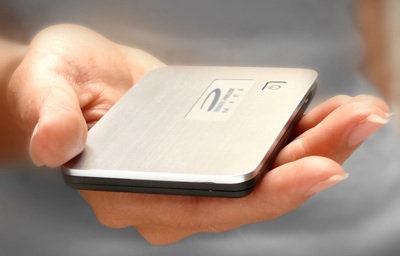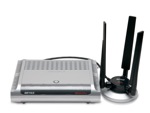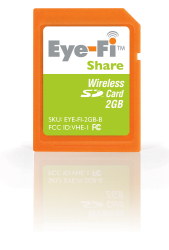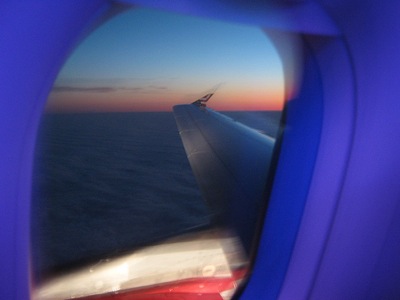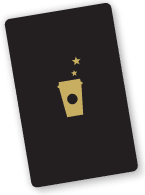Let’s look back and forward: It’s traditional to wrap up the year, during a quiet news period, by looking at what just went by. This is the one time of year that I also prognosticate, and I got lucky: My forecast for 2008 made a year ago turns out to be weirdly accurate. I don’t mean to take too much credit, though: I was expecting big news from things in 2008 that were much quieter affairs.
In-flight Internet (over Wi-Fi). It took almost until the end of the year, but this expectation finally became fulfilled not quite in the form or extent I envisioned. Several companies are separately pursuing offering in-flight Internet, but only Aircell managed to put the service into planes. American Airlines, Virgin America, and Delta Airlines all lofted flights in 2008 with broadband on board.
Of course, the expectation was that between 300 and 500 planes would be equipped with one vendor or another’s flavor of in-flight Internet in 2008. Instead, the total is about 25 to 30 across those three airlines. Ryan Air’s multi-year promise to put OnAir service on its European routes hasn’t yet gone into public trials. Southwest and Alaska’s promised tests of Wi-Fi appear to be invisible.
Still, Alaska and JetBlue both told me that there’s work ahead in 2009, and Delta said it would equip over 300 planes in 2009 in its fleet, and start equipping its merger partner Northwestern Airlines with Internet service in 2009 as well.
We can count 2008 as the year in-flight Internet taxied down the runway; 2009 will likely be the year that it takes off. Whether it’s financially viable is a different story; but it appears that service will be available on perhaps 20 to 30 percent of wide-body jetsfor routes within the U.S. in 2009.
Wi-Fi in every smartphone. Here, I feel I nailed it. It wasn’t too much to call this, but Research in Motion and other established phone makers still seemed to have a slight resistence to including Wi-Fi. Now, it’s de rigeur. The iPhone 3G and first Android phone, the T-Mobile G1, shipped in 2009 with Wi-Fi along with Bluetooth, 2G and 3G radios, and GPS. Wireless all around. The BlackBerry Storm was widely criticized for being an iPhone me-too without the quality, but also because it lacked Wi-Fi; most other new BlackBerrys are fully Wi-Fi’d.
Tens of millions of smartphones now have Wi-Fi built in—about 10 million of those are iPhones alone. I’m not sure if the industry tracks this, but the mark of 100 million Wi-Fi equipped smartphones will certainly hit in the first quarter of 2009.
The new trend I call for 2009 is the inclusion of Wi-Fi in so-called feature phones, the inexpensive phones that offer far more limited capabilities than smartphones. Talking to chipmakers and handset makers in 2008 made it clear that Wi-Fi chips will be available in early 2009 with low-enough power at an inexpensive price with better integration for multiple wireless standards. This makes it affordable and keeps batteries from being drained.
Carriers want Wi-Fi as a way to offload usage from celluar networks, especially in people’s home, and putting Wi-Fi into feature phones gives carriers an advantage in stretching scarce spectrum even further.
Wi-Fi everywhere. With municipal Wi-Fi in its 2004-2006 form dead in 2007 and buried in the first half of 2008, we’ve seen a resurgence in efforts to put a plan in place first (why do we need Wi-Fi or some other wireless technology?) and then build a network.
In a round-up for Ars Technica six weeks ago, I highlighted several cities that have working large-scale networks all built for slightly different purposes. These networks are all successful in the sense that they have been built and appear to be working for the purpose for which they were intended. Only time will tell—another year or even two—as to whether the long-term benefits or sustainability are there.
I also said a year ago that 2008 would be the year of hotspot saturation. I think I was right on that. It’s hard to find any venue in North America and Europe that lacks Wi-Fi. Wayport’s acquisition of Opti-Fi airports and Parsons’s Washington State Ferry operations, along with AT&T’s purchase of Wayport demonstrated that consolidation had arrived, too. (Wayport operated Wi-Fi in U.S. McDonald’s locations, and managed AT&T’s Wi-Fi hotspots.)
Starbucks switching to AT&T and offering loyalty-based free service to customers, as well as AT&T radically expanding free access to its hotspot network, dramatically expanded the ability to get Wi-Fi for nothing.
Years ago, I was somewhat excoriated for saying that Wi-Fi hotspot access will either be free or cost you $20. Some people insisted Wi-Fi would trend to zero—some even cite Starbucks 2-hours-a-day loyalty reward as proof, even though you need to make a regular purchase to get the “free” service. Others insisted that you would need several subscriptions, each at $20 to $40 per month, to have a national or international personal footprint.
I wasn’t too far off, in the end. If you want, there are now extensive networks in the U.S. and Europe of free hotspots and AT&T gives free Wi-Fi to about 15 to 20 million customers. The Fon network, however you count it, seemingly offers reciprocal free Wi-Fi to as many as hundreds of thousands of its Foneros.
If you want a larger pool of access at premium venues, especially airports and hotels, you can pay a bit more than $20 per month—maybe I should give myself the benefit of inflation, since I’ve been saying $20 for a few years? Boingo offers unlimited Wi-Fi for North America for $21.95 per month; iPass includes dial-up and Ethernet service as well for $29.95 per month. (Internationally, aggregators meter service because of the exceedingly high cost in some markets. You can get a few thousand minutes a month for about $45 with iPass or $60 with Boingo.)
WiMax arrives. Again, slipping in towards the 11th hour, my prediction that WiMax would be deployed widely enough to see whether it works wasn’t precisely what happened. WiMax is commercially available in one market—Baltimore—although reports from reviewers and residents seem to all be positive.
The new Clearwire, a product of the old Clearwire firm and the WiMax division and spectrum portfolio of Sprint Nextel, will launch its first market under the Clear product name in Portland, Ore., on Jan. 6 (badly timed before CES and Macworld Expo). Then they’ll start rolling out cities on a regular basis.
Gadget-Fi a go-go. I’m now going on about 3 years of saying that next year, Wi-Fi will be in everything. It’s getting there. I’m still waiting for a good implementation of Wi-Fi in a camera, but at least the Eye-Fi adapter—which debuted in 2007 and expanded options in 2008—provides a good substitute.
Apple apparently shipped a jillion iPod touch players; they don’t reveal specific model unit shipments, but it’s possible that several million iPod touch models are in people’s hands.
What’s Coming in 2009?
A real security meltdown for some version of WPA. I hate to say this, because it sounds like fear mongering, but after the clever but not significant WPA exploit revealed a few weeks ago, it’s clear to me that worse is to come. We will likely see the death of the TKIP (Temporal Key Integrity Protocol) flavor of 802.11i (supported in WAP and WPA2), at least in the pre-shared key/Personal flavor in 2009 due to additional weaknesses that relate to backwards compatibility with the long-depreated WEP.
Whatever attack results, it will likely still require a lot of effort on the part of the attacker, but will have a chilling effect, and move more people to the AES-CCMP flavor of encryption available only in WPA2.
LTE. Long Term Evolution, the GSM-evolved fourth-generation (4G) cell data standard, should appear in commercial form in 2010, but we’re going to hear a lot about it in 2009. We may even see some test markets. Verizon sounds like they promised at least one production market for regular use.
LTE and WiMax convergence. There’s apparently enough interest in converging the mismatched elements of LTE and WiMax that we may see a full-fledged convergence effort in 2009. This would mean that nearly all 4G efforts worldwide could come together around two intercompatible standards.
Train Fi. Yes, I’ve been writing about Internet access in trains for a few years. It’s finally arrived. The faster cellular data speeds, the brief huge spike in oil prices, and lengthy tests that have concluded successfully are finally leading to Wi-Fi-based access being installed on commuter and long-haul trains worldwide. In the U.S., the BART system in the San Francisco Bay Area could wind up being the largest such deployment in 2009. But train-Fi has broken out all over.
SMS Fi. Twitter or a firm like it will move to supplant the ridiculous cost of SMS, especially for smartphone owners with unlimited data plans, by offering an SMS-like service for a pittance with gateway service to existing SMS offerings. Wi-Fi and 3G will be the preferred method. With carriers pursuing predatory pricing on SMS, the only universal messaging format, an alternative will be formed out of the pressure. Coal becomes diamond.
Very high speed Wi-Fi’s first steps. In 2008, representatives most from chipmakers worked through the formation of two new 802.11 task groups for Very High Throughput wireless LANs: one, formed late in the year, 802.11ac will cover frequencies below 6 GHz; the other, likely to be 802.11ad, will cover the 60 GHz band, used for millimeter-band radar and with SiBeam’s video streaming approach. The goal is for 1 Gbps or faster raw throughput rates. A timeline isn’t yet set; given how the group and manufacturers work, it might be 2010 before we see 802.11ac devices and longer for 802.11ad.
What Was Hot in 2008?
The top stories by page views for 2008 were mostly stories from years before. While readers were most interested in T-Mobile losing its Starbucks contract to AT&T (February), they also looked at a pair of 2003 items on WPA passphrase weakness (my introduction and a paper on the topic), perused my outdated 2006 essay on not buying into early Draft N gear, and followed a dead link from an item about installing a free WPA client (no longer available) for Windows 2000.
Also in 2008, readers were equally interested in a third-quarter 2008 review of Linksys’s WRT610 router—but more people read the 2007 review of the preceding WRT600 model. And apparently people still aren’t changing their WRT54G’s admin password, given that it’s the No. 4 story for 2008, but published in 2004.
Perversely, a top story in 2008 was a review I wrote in 2004 of an early Wi-Fi signal finder, a category of product that now seems tediously useless. Showing that people are interesting in what Wi-Fi means (literally), a 2005 story on the origins of the choice of the Wi-Fi name still gets a lot of attention.
Of the top 15 or so stories, all but 2 were from before 2008, and three-quarters were about security.
Wee-Fi: Bullet Train-Fi, Curve-Fi (No 3G)
The New Clearwire Taking Orders in Portland, Ore.
Music industry ends mass piracy lawsuits
(Reuters)



